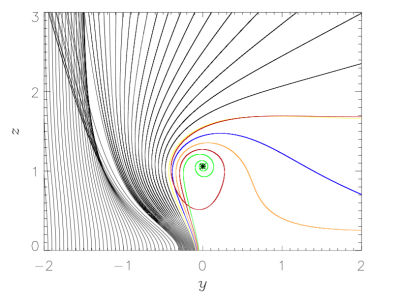Description
The concept of sound waves is familiar to us since they fill the air around us. However, in more exotic environments like the Sun's atmosphere a whole host of different waves are supported that we don't see in our everyday lives. Rather than a predominantly neutral gas like air, the solar atmosphere is comprised of super-heated electrically conducting plasma threaded by a magnetic field. The coupling between the plasma and magnetic field leads to several different types of waves, with sound waves being a limiting case.
Mathematically, the coupling between the fluid-like plasma and the magnetic field is described by the equations of Magnetohydrodynamics (MHD). MHD is essentially the fusion of Navier Stokes and Maxwell's equations. The different wave modes can be explored by considering the linear behaviour of these equations.
 Ray paths of an MHD wavefront (from McLaughlin et al. (2019)).
Ray paths of an MHD wavefront (from McLaughlin et al. (2019)).
This project will begin by considering the general form of these wave modes and then explore their behaviour given certain simplifying assumptions. We will follow the methodology set out in McLaughlin et al. (2019) whereby the linearised equations are solved using Charpit's method (similar to the method of characteristics), allowing ray paths to be constructed for a given background magnetic field. You will be encouraged to write your own Python code to reproduce the ray paths shown above. Once the code is developed, there is plenty of scope for exploring how changes in the parameters affect the different waves.
Prerequisites
Partial Differential Equations III is essential. It is strongly recommended that you take Continuum Mechanics III alongside this project.
Resources
There are several excellent sets of lecture notes online covering MHD waves. See for instance these notes from St. Andrews or Sheffield. A useful textbook description of how to solve initial value problems is given in Chapter 2 of A student's guide to numerical methods. The methedology for creating ray paths is described in detail in McLaughlin et al. (2019). An excellent textbook explaining the MHD equations and the waves they support can be found in the library, Magnetohydrodynamics of the Sun.